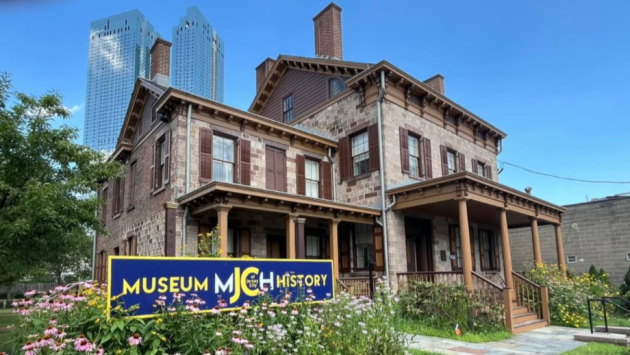Jersey City Times: Baseball on Belmont Avenue: The Backstory of Lincoln Park
- Museum Jersey City History
- Aug 7
- 4 min read
Baseball on Belmont Avenue: The Backstory of Lincoln Park
This is the fifth in a weekly series of essays on Jersey City’s illustrious sports history. It complements the Museum of Jersey City History’s current exhibit Legendary Arenas… and the Legends Who Performed There at the Apple Tree House (298 Academy Street). The exhibit is open to the public on Wednesdays and Saturdays from 1:00 to 5:00 pm. until October 15.
by Peter Begans
August 8, 2025

The area we now call Lincoln Park was once the site of the Jersey City Golf Club and the baseball home of the Jersey City Skeeters of the Eastern League (1902–1905). The Jersey City minor league baseball club had played at different ballparks throughout Jersey City since 1885. These included the Grand Street Grounds downtown and Oakland Park in Jersey City Heights. But beginning in 1902, the Skeeters ― who drew their nickname from the winged insects that infested the city’s swampy west side ― moved into the land on lower Belmont Avenue below the present-day St. Aloysius Church and school. A photo of the ballpark shows it had a grandstand that stretched the length of the infield and bleachers that ran up each outfield line.

Memoirist Florence Pond Graham, who grew up on Bentley Avenue, had memories of the team and its ballpark. “The diamond was where the fountain is now. Friday was Ladies’ Day and I remember walking down the hill with my mother and a friend or two of hers, each of them carrying a parasol and wearing long sweeping skirts.” (Florence Pond Graham, Jersey City: As I Remember It)
Most years the Skeeters were an average ball club, but in 1903 the team made a run for greatness. Led by player–manager Billy Murray and three 20-game winning pitchers, the 1903 Skeeters would win their first 16 games, then rip off a streak of 25 straight late in the season to finish 92–33. The Skeeters would win the Eastern League pennant but lose the post-season playoff. Despite that disappointment, in 2001 the National Association of Professional Baseball Leagues would rank the 1903 Skeeters No. 7 on the list of all-time greatest minor league teams.
Jersey City had great affection for its team, but Hudson County had designs on the Skeeters’ stadium. The county park commission needed the land to create a stunning urban park in the City Beautiful tradition, with winding pathways, summer houses, and a decorous central fountain. Unfortunately, there would be no room for the Skeeters. They would have to move.
The public was alarmed. “Disturbing rumors were circulated to the effect that all of the athletic organizations which had their fields on the park site, and especially the Jersey City baseball club, would be shut out for the season of 1905, and compelled to give up their amusement,” wrote the Evening Journal. “Thousands, who have been in the habit of attending the ball games and taking part in other sports heard the rumors with regret and remonstrance. Petitions were circulated and signed requesting the commission to allow the organizations to remain as long as possible…”And the politicians listened. “In response, the commission at its meeting on April 5, 1905, decided to let the various clubs and organizations that have been playing on the park site continue, with the understanding that they were not to impede the progress of the work of the commission. The news of the commission’s decision met with general satisfaction, and the club seasons were not seriously interfered with.”
The Skeeters would find a new home. And once completed, the new county park at the foot of Belmont Avenue would provide superb recreation facilities for the city’s growing population. There were tennis courts where competitive matches were held each year, baseball diamonds for young and old, and a 440-yard cinder oval where championship track-and-field meets would be contested for decades.
No one dominated the cinders in the 1940s and early 1950s like Andy Stanfield of Lincoln High School. He would lead Lincoln to two city and county championships along with his running mate James Williams, Jr. Stanfield would enjoy an All-American career at Seton Hall University and go on to win two gold medals at the 1952 Olympics in Helsinki. He set the Olympic mark in the 200 meters, and he was part of the winning USA 4X100 relay. Stanfield also earned a silver medal at the 1956 Olympics in Melbourne in the 200 meters. In 1977, he would be inducted into the United States Track and Field Hall of Fame.
Another outstanding Lincoln H.S. legend in track and field was the versatile Charlie Mays. Mays was named AAU Track-and-Field Athlete of the Year on three occasions for his achievements in varied events. He was nine-time AAU champion in the long jump and six-time champion in the 440-yard dash. Twice he was NCAA champion in the long jump and the mile relay. Mays went on to represent the United States in the long jump at the 1968 Summer Olympics in Mexico City. In 1973, he founded the Black Athletes Hall of Fame and later served as its executive director. In 2007, Hudson County named the refurbished running track at Lincoln Park in his honor.
About Peter Begans
Peter Begans is the curator of MJCH’s Legendary Arenas… and the Legends Who Performed There. He was born and raised in Jersey City and has had a long career as a teacher, journalist, speechwriter and public affairs representative.




Comments